
The number of Ukrainian users of the Instagram social network in 2019 increased by 4.5%, to 11.5 million (about 11 million in 2018), the number of Facebook users by 7.7%, to 14 million. Such research data of the Ukrainian audience of social networks was released by PlusOne communications agency on its website.
According to the study, the main increase in Instagram audience was due to users 19-27 years old, and the increase in Facebook audience was mainly due to users aged 39 or more. Moreover, in almost all regions of Ukraine, except for Kharkiv region, Facebook is more popular than Instagram, and most users prefer the mobile version of the network rather than desktop.
“Ukraine ranks second in the world in the number of women registered in popular social networks. It ranks second in the world in the number of women who are Facebook users and is in the top ten countries in the number of Instagram users. In addition, the female audience of Facebook and Instagram outweighs the male in all age categories,” according to the report.
According to the PlusOne study, in October-December 2019, as well as January 2020, the Facebook Messenger audience in Ukraine increased by 1.5 million users, to 8.7 million.
At the same time, the report indicates that the total audience of Ukrainians available to advertisers through Facebook instruments is 19.5 million users.
Instagram, according to the study, achieved the highest penetration in Kyiv (45%), Odesa (36%) and Kharkiv (34%) regions. Whereas Facebook is the most popular in Kyiv (penetration is 55%), Lviv (44%), and Zakarpattia (40%) regions.

The number of regular Internet users in Ukraine by the end of the third quarter of 2019 (Q3) increased by 7% to 22.96 million, the Ukrainian Internet Association (UIA) reported on its website with a link to the results of a study by Factum Group Ukraine.
The Association notes this indicator for the first time in the past few years has grown significantly. The main reasons for the growth in the association are called ‘smartphoneization’ of the population and an increase in the number of network users in villages and small towns.
So, by the end of September, Internet penetration increased from 71% to 74% in towns whose population exceeds 100,000 inhabitants, from 63% to 70% in towns whose population is lower than 100,000 inhabitants, and from 53% to 58% in villages.
“Alignment of the structure of Internet users in accordance with the structure of the population continues. This process has actually been completed by gender, and continues by other indicators: regional, professional, educational, income, age. Almost all Ukrainians younger than 35 are Internet users,” the Association said when commenting on the findings of the survey.
The most active users are Ukrainians aged 15-24 years (97% of Internet users), they are followed by people aged 25 to 34 years (96%). Users over 65 years old account for 29% (only 14% a year ago). The share of women in the total number of Internet users is still 52%.
Some 44% of Ukrainian Internet users have an average income level, 48% are below average. Some 40% have secondary specialized education, 36% have complete higher education.
The first place among Internet devices is a smartphone (66%), the second is a home laptop (40%), and the third is a PC (36%).
The share of users using exclusively mobile devices for access to the Internet in Q3 was 22%.

The share of 4G Internet users in Ukraine by late 2019 would double, to 16%, Leading Expert for Designing Mobile Communications System at Ericsson Ukraine Volodymyr Yereschenko has said. “The number of 4G users relative to the share of all other technologies will increase approximately twice in a year,” he told Interfax-Ukraine in Kyiv on Thursday after the presentation of the June Ericsson Mobility Report.
The low rate of coverage of users of the 4G network Yereschenko explained, in particular, by limited coverage and the lack of a sufficient number of subscriber terminals.
“4G was started to be built only recently, about a year ago. They installed equipment in big cities. At the same time, there is no coverage in small cities, villages, on the highways – this is the first reason. The second is that not all subscriber terminals support 4G. Many terminals are connected to operators’ networks without 4G support, as well as some users still have not replaced old SIM cards with eSIM (with 4G support). As practice shows, the terminal is changed once in several years,” he said.
Industry Marketing Director at Ericsson Peter Jonsson also said that such low coverage of 4G users indicates a potential for further growth.
“8% is not enough, but it also means that there is potential. According to GSMA, by 2024 the percentage of 4G users can grow to 50%. As a rule, the further growth of the share depends on the cost of 4G subscriptions, availability of coverage and terminals as well as the profitability of the transition from 3G to 4G for operators,” Jonsson said.
In 2018, the share of 4G users in Ukraine was 8%, 3G was used by 52%, and another 35% were connected to 2G, Jonsson said.